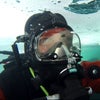The Saint Maurice Cathedral of Angers (French: Cathédrale Saint-Maurice d'Angers) is the seat of the Roman Catholic Diocese of Angers in Angers, France.
Built between the 11th and 16th Centuries, It was classified in 1862 as a national monument of France for its mixture of Romanesque and Gothic architectural styles, especially the Angevin Gothic style, and for the stained glass windows, including the transept's window of Saint Julian, considered to be a masterpiece of French 13th century glasswork.
The original Romanesque church was rebuilt with Gothic details in the mid-12th century. The single-aisle plan was vaulted with pointed arches resting on a re-clad interior elevation. The nave consists of three simple bays, with single bays on either side of a crossing forming transepts, followed by a single-bay choir, backed by an apse.
The Cathedral of Angers was originally dedicated to the Virgin Mary. But, in 396, St. Martin, the Archbishop of Tours, added St. Maurice to the dedication. He had acquired a relic of some of the blood of the members of the Theban Legion, who were martyred, along with their leader St. Maurice, in the 3rd Century for converting to Christianity. The relic was brought to Tours and later, according to legend, a phial of it was given to Angers. In the 7th Century, a devotion to St. Maurilius, the Bishop of Angers in the 4th Century, began. A biography of him was written and, in 873, his body was transferred to the Cathedral. Two hundred years, St. Maurilius and St. Maurice were frequently mentioned together as the patron saints of the Cathedral but eventually St. Maurice became the primary patron of the Cathedral.
At the beginning of the eleventh century, Hubert de Vendôme, the Bishop of Angers from 1010 to 1047, wanted to build a new cathedral in the Romanesque style to replace a small and humble church. The new church was consecrated on 16 August 1025 but, seven years later, in 1032, right after the completion of the construction, it was burned to the ground.
However, Geoffroy de Tours, the Bishop of Angers from 1081 to 1093, ordered the reconstruction of the Cathedral, which continued under the supervision of his successors, Renaud de Martigné (1102–1125), Ulger (1125–1148) and Normand de Doué (1148–1153). During the rebuilding, the altar crucifix was blessed in 1051 and the new altar was consecrated in 1096. The new church was finally finished in the first half of the thirteenth century, under the crosier of Guillaume de Beaumont, the Bishop of Angers from 1203 to 1240.
Consequently, the Cathedral underwent a series of changes. In the 16th Century, the gallery, featuring the knight-companions of St. Maurice, was built by Jean Delespine and the facade was added. The spire in the Renaissance style, with a hexagonal crown, was placed on the cusp of the north tower in 1518, and an identical tower was also built, in 1523, on the cusp of the south tower.
During the Middle Ages, both the Angers Cathedral and the Amiens Cathedral claimed that they were in possession of the reputed head of St. John the Baptist, which had been brought to France from the Fourth Crusade but had since been lost.
In 1806, the porch, which stood in front of the facade, had to be demolished because of its dilapidated condition. Built in the Angevin Gothic style in front of the entrance's gate, it had two levels but, today, the four pointed arches are the only remaining evidence of the medieval porch. Various reconstruction projects were developed in the 20th Century but none of them made it out of the planning stage.
The pipe organ has been in the Cathedral as early as the 14th Century. But the current incarnation was built only in 1617 by the organ maker, Jacques Girardet, who was probably recycling the pipes and other parts from the previous organ. An earlier organ was replaced in 1416 with a new case by Jean Chabencel but in 1451 it burned down, struck by a lighting bolt. A replacement was built in 1507 on the initiative of Anne of Brittany on the original spot, the counter in the choir. It was restored for the first time, after a fire, in 1533 by Peter Bert and for the second time, in 1701 by Marin Ingoult, who added the pedalboard. When Ingoult was done, the organ had, besides the pedalboard, 47 pipes with four keyboards (manuals). In the 18th Century, its case was replaced. Between 1869 and 1872, the organ was reorganized by Aristide Cavaillé-Coll. In 1957 it was electrified, adding 19 pipes for the total of 66 pipes, with just three manuals and a pedalboard. It is in the balcony of the counter at the west end of the Cathedral.
Among these significant works in the cathedral are:





